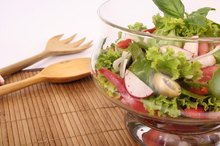What is the Diet for a 42 Year Old Woman?
Women’s bodies and nutritional needs change over the years. If you’ve reached age 42 without shifting your diet, you may gain weight or experience vitamin or mineral deficiencies. Take charge as you approach 50, and more major changes with menopause, by adjusting your nutritional profile to meet future needs. Following a low-fat, balanced diet drawn from every food group will help you control your weight and get the vitamins and minerals you need to avoid chronic illnesses for which older women are at risk.
Caloric Intake
Your body composition may begin to change in your 40s, replacing muscle mass with fat that causes weight gain. Women’s risks for heart disease, cancer, diabetes and arthritis increase with overweight conditions. Get your doctor’s help in setting calorie boundaries in your diet for weight loss or weight maintenance. The U.S. Department of Agriculture recommends an average intake of 1,600 to 2,400 calories daily. Trimming your normal intake by 500 calories per day as you increase physical activity will help you lose weight safely.
Nutrients to Emphasize
The Advantages of Not Eating Fast Foods
Learn More
Women’s requirements for calcium, vitamin D, iron and vitamin B12 may increase as the body’s ability to store or utilize these nutrients decreases. To avoid osteoporosis, begin a daily practice of drinking low-fat or non-fat milk for its calcium, vitamin D, vitamin B12 and potassium. Adequate potassium helps keep your blood pressure in the normal range, offsetting your growing risk for hypertension in your mid-40s. Eating some fortified cereals provides a full day’s supply of iron and vitamin B to prevent anemia, as well as supplying fiber to help control your weight and cardiovascular risk. Other low-fat foods in the protein, dairy, grain, vegetable and fruit groups contribute the rest of the nutrients needed to sustain women’s health.
Nutrients to Limit
To alleviate your increasing cardiovascular risk in your 40s, you must limit dietary elements that clog blood vessels and increase blood pressure. The USDA considers saturated and trans fat, cholesterol, sugar and sodium important nutrients to restrict in your daily meals. By eating more fish, beans, whole grains and unsaturated oils and less fatty meats, butter and sweetened commercial baked goods, you reduce your solid fat, cholesterol and sugar intakes. This improves your cardiovascular health and promote a proper body weight. Limiting foods with added salt, the main source for sodium, benefits your blood pressure. Read food labels and choose foods with less of these “risky” nutrients.
Calorie Depletion
The Best Diet Plan for Men Over 50
Learn More
Your need for exercise to deplete excess calories does not fade with age. To enjoy occasional desserts, sodas, alcohol and other treats in your diet, work off the greater calories that sugar and fat impart. The National Women’s Health Information Center recommends 150 minutes of aerobic activity such as cycling, brisk walking or sports play per week. To mitigate muscle and bone density loss, which can both occur in your 40s, add strengthening exercises such as weight lifting or resistance band training twice a week to improve your musculoskeletal health.
Related Articles
References
Writer Bio
Nancy Clarke began writing in 1988 after achieving her Bachelor of Arts in English and has edited books on medicine, diet, senior care and other health topics. Her related affiliations include work for the American Medical Association and Oregon Health Plan.









